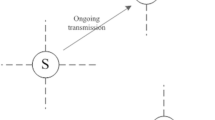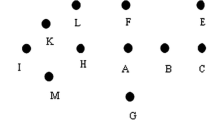Abstract
Using directional antennas in wireless mobile ad hoc networks can greatly improve the transmission range as well as the spatial reuse. However, it will also cause some problems such as deafness problem and hidden terminal problem, which greatly impair the network performance. This paper first proposes a MAC protocol called Selectively Directional MAC (SDMAC) that can effectively address these problems and significantly improve the network throughput. Then two improvements on SDMAC are proposed. The first one is to improve the network throughput by scheduling the packets in the queue (a scheme called Q-SDMAC), thus the head-of-line (HOL) blocking problem can be addressed. The second one is to relax the assumption that each node knows the relative directions of its neighboring nodes and use caches to buffer those relative directions (a scheme named Q-SDMAC using cache). Extensive simulations show that: (1) SDMAC can achieve much better performance than the existing MAC protocols using directional antennas; (2) The network throughput can be significantly improved by scheduling the packets in the queue; (3) Using caches can still achieve high network throughput when nodes are moving; and (4) Network throughput decreases when directional antennas have side lobe gain.
Similar content being viewed by others
References
Wireless lan medium access control (mac) and physical layer (phy) specifications. IEEE Standards Working Group, (1999)
Choudhury, R. R., & Vaidya, N. H. (2004). Deafness: A mac problem in ad hoc networks when using directional antennas. In Proceedings of the 12th IEEE International Conference on Network Protocols (ICNP), October 2004, pp. 283–292.
Choudhury, R. R., Yang, X., Vaidya, N. H., & Ramanathan, R. (2002). Using directional antennas for medium access control in ad hoc networks. In Proceedings of the 8th ACM Annual International Conference on Mobile Computing and Networking (MOBICOM), September 2002, pp. 59–70.
Gossain, H., Cordeiro, C. M., Cavalcanti, D., & Agrawal, D. P. (2004). The deafness problems and solutions in wireless ad hoc networks using directional antennas. In IEEE Global Telecommunications (GlobeCom) Workshop on Wireless Ad Hoc and Sensor Networks, November 2004, pp. 108–113.
Li, G., Yang, L. L., Conner, W. S., & Sadeghi, B. (2005). Opportunities and challenges in mesh networks using directional anntenas. In Proceedings of IEEE WiMesh, September 2005.
Kolar, V., Tilak, S., & Abu-Ghazaleh, N. (2004). Avoiding head of line blocking in directional antenna. In Proceedings of the 29th Annual IEEE International Conference on Local Computer Networks (LCN), November 2004, pp. 385–392.
Ramanathan, R. (2001). On the performance of ad hoc networks with beamforming antennas. In Proceedings of the 2nd ACM International Symposium on Mobile Ad Hoc Networking and Computing (MobiHoc), October 2001, pp. 95–105.
Taikai, M., Martin, J., Ren, A., & Bagrodia, R. (2002). Directional virtual carrier sensing for directional antennas in mobile ad hoc networks. In Proceedings of the 3rd ACM International Symposium on Mobile Ad Hoc Networking and Computing (MobiHoc), June 2002, pp. 183–193.
Ko, Y., & Vaidya, N. H. (2000). Medium access control protocols using directional antennas in ad hoc networks. In Proceedings of␣19th Annual Joint Conference of the IEEE Computer and Communications Societies (Infocom), March 2000, vol. 1, pp.␣13–21.
Nasipuri, A., Ye, S., & Hiromoto, R. (2000). A mac protocol for mobile ad hoc networks using directional antennas. In Proceedings of the IEEE Wireless Communications and Networking Conference (WCNC), September 2000.
Korakis, T., Jakllari, G., & Tassiulas, L. (2003). A mac protocol for full exploitation of directional antennas in ad-hoc wireless networks. In Proceedings of the 4th ACM International Symposium on Mobile Ad Hoc Networking and Computing (MobiHoc), June 2003, pp. 98–107.
Li, Y., & Safwat, A. M. (2005). Efficient deafness avoidance in wireless ad hoc and sensor networks with directional antennas. In Proceedings of the 2nd ACM International Workshop on Performance Evaluation of Wireless Ad Hoc, Sensor, and Ubiquitous Networks (PE-WASUN), Montreal, Quebec, Canada, October 2005, pp. 175–180.
Gossain, H., Cordeiro, C. M., Cavalcanti, D., & Agrawal, D. P. (2005). Mda: An efficient directional mac scheme for wireless ad hoc networks. In Proceedings of IEEE Global Telecommunications (GlobeCom), November 2005.
Liberti, J., & Rappaport, T. (1999). Smart antennas for wireless communications. Prentice-Hall PTR.
Janaswamy, R. (2001). Radiowave propagation and smart antennas for wireless communications. Boston: Kluwer Academic Publishers.
Ramanathan, R., Redi, J., Santivanez, C., Wiggins, D., & Polit, S. (2005). Ad hoc networking with directional antennas: A complete system solution. IEEE Journal on Selected Areas in Communications, 23(3), 496–506.
Ueda, T., Tanaka, S., Roy, S., Saha, D., & Bandyopadhyay, S. (2004). Location-aware power-efficient directional mac protocol in ad hoc networks using directional antenna. IEICE Transactions on Communications 2005, E88-B(3), 1169–1181.
Bhagwat, P., Bhattacharya, P., Krishna, A., & Tripathi, S. K. (1996). Enhancing throughput over wireless LANs using channel state dependent packet scheduling. In Proceedings of IEEE Infocom, March 1996, vol. 3, pp. 1133–1140.
Wang, J., Zhai, H., & Fang, Y. (2004). Opportunistic packet scheduling and media access control for wireless LANs and multi-hop ad hoc networks. In Proceedings of IEEE Wireless Communications and Networking Conference (WCNC’04), March 2004, pp. 1234–1239.
Acknowledgments
The work of Li, Zhai and Fang was supported in␣part by U.S. National Science Foundation (NSF) under Grant CNS-0721744 and GrantDBI-0529012. The work of Fang was also supported in part by the National Science Council (NSC), ROC, under the NSC VisitingProfessorship with contract number NSC-96-2811-E-002-010.
Author information
Authors and Affiliations
Corresponding author
Rights and permissions
About this article
Cite this article
Li, P., Zhai, H. & Fang, Y. SDMAC: Selectively Directional MAC protocol for wireless mobile ad hoc networks. Wireless Netw 15, 805–820 (2009). https://doi.org/10.1007/s11276-007-0076-z
Published:
Issue Date:
DOI: https://doi.org/10.1007/s11276-007-0076-z




